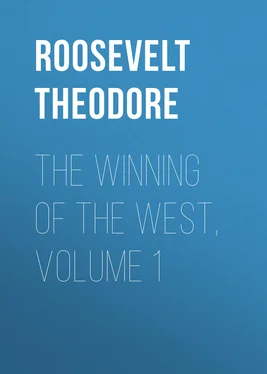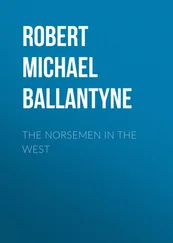Theodore Roosevelt - The Winning of the West, Volume 1
Здесь есть возможность читать онлайн «Theodore Roosevelt - The Winning of the West, Volume 1» — ознакомительный отрывок электронной книги совершенно бесплатно, а после прочтения отрывка купить полную версию. В некоторых случаях можно слушать аудио, скачать через торрент в формате fb2 и присутствует краткое содержание. Жанр: foreign_prose, История, foreign_edu, foreign_antique, на английском языке. Описание произведения, (предисловие) а так же отзывы посетителей доступны на портале библиотеки ЛибКат.
- Название:The Winning of the West, Volume 1
- Автор:
- Жанр:
- Год:неизвестен
- ISBN:нет данных
- Рейтинг книги:5 / 5. Голосов: 1
-
Избранное:Добавить в избранное
- Отзывы:
-
Ваша оценка:
- 100
- 1
- 2
- 3
- 4
- 5
The Winning of the West, Volume 1: краткое содержание, описание и аннотация
Предлагаем к чтению аннотацию, описание, краткое содержание или предисловие (зависит от того, что написал сам автор книги «The Winning of the West, Volume 1»). Если вы не нашли необходимую информацию о книге — напишите в комментариях, мы постараемся отыскать её.
The Winning of the West, Volume 1 — читать онлайн ознакомительный отрывок
Ниже представлен текст книги, разбитый по страницам. Система сохранения места последней прочитанной страницы, позволяет с удобством читать онлайн бесплатно книгу «The Winning of the West, Volume 1», без необходимости каждый раз заново искать на чём Вы остановились. Поставьте закладку, и сможете в любой момент перейти на страницу, на которой закончили чтение.
Интервал:
Закладка:
The Cherokees, some twelve thousand strong, 38 38 "Am. Archives," 4th Series, III., 790. Drayton's account, Sept. 23, '75. This was a carefully taken census, made by the Indian traders. Apart from the outside communities, such as the Chickamaugas at a later date, there were: 737 gun-men in the 10 overhill towns 908 " " 23 middle " 356 " " 9 lower " a total of 2,021 warriors. The outlying towns, who had cast off their allegiance for the time being, would increase the amount by three or four hundred more.
were the mountaineers of their race. They dwelt among the blue-topped ridges and lofty peaks of the southern Alleghanies, 39 39 "History of the American Indians, Particularly Those Nations Adjoining to the Mississippi, East and West Florida, Georgia, South and North Carolina, and Virginia." By James Adair (an Indian trader and resident in the country for forty years), London, 1775. A very valuable book, but a good deal marred by the author's irrepressible desire to twist every Indian utterance, habit, and ceremony into a proof that they are descended from the Ten Lost Tribes. He gives the number of Cherokee warriors at 2,300.
in the wild and picturesque region where the present States of Tennessee, Alabama, Georgia, and the Carolinas join one another.
To the west of the Cherokees, on the banks of the Mississippi, were the Chickasaws, the smallest of the southern nations, numbering at the outside but four thousand souls; 40 40 Hawkins, Pickens, Martin, and McIntosh, in their letter, give them 800 warriors: most other estimates make the number smaller.
but they were also the bravest and most warlike, and of all these tribal confederacies theirs was the only one which was at all closely knit together. The whole tribe acted in unison. In consequence, though engaged in incessant warfare with the far more numerous Choctaws, Creeks, and Cherokees, they more than held their own against them all; besides having inflicted on the French two of the bloodiest defeats they ever suffered from Indians. Most of the remnants of the Natchez, the strange sun-worshippers, had taken refuge with the Chickasaws and become completely identified with them, when their own nationality was destroyed by the arms of New Orleans.
The Choctaws, the rudest and historically the least important of these Indians, lived south of the Chickasaws. They were probably rather less numerous than the Creeks. 41 41 Almost all the early writers make them more numerous. Adair gives them 4,500 warriors, Hawkins 6,000. But much less seems to have been known about them than about the Creeks, Cherokees, and Chickasaws; and most early estimates of Indians were largest when made of the least-known tribes. Adair's statement is probably the most trustworthy. The first accurate census showed the Creeks to be more numerous.
Though accounted brave they were treacherous and thievish, and were not as well armed as the others. They rarely made war or peace as a unit, parties frequently acting in conjunction with some of the rival European powers, or else joining in the plundering inroads made by the other Indians upon the white settlements. Beyond thus furnishing auxiliaries to our other Indian foes, they had little to do with our history.
The Muscogees or Creeks were the strongest of all. Their southern bands, living in Florida, were generally considered as a separate confederacy, under the name of Seminoles. They numbered between twenty-five and thirty thousand souls, 42 42 Hawkins, Pickens, etc., make them "at least" 27,000 in 1789, the Indian report for 1837 make them 26,844. During the half century they had suffered from devastating wars and forced removals, and had probably slightly decreased in number. In Adair's time their population was increasing.
three fourths of them being the Muscogees proper, and the remainder Seminoles. They dwelt south of the Cherokees and east of the Choctaws, adjoining the Georgians.
The Creeks and Cherokees were thus by their position the barrier tribes of the South, who had to stand the brunt of our advance, and who acted as a buffer between us and the French and Spaniards of the Gulf and the lower Mississippi. Their fate once decided, that of the Chickasaws and Chocktaws inevitably followed.
The customs and the political and social systems of these two tribes were very similar; and those of their two western neighbors were merely ruder copies thereof. They were very much further advanced than were the Algonquin nations of the north.
Unlike most mountaineers the Cherokees were not held to be very formidable fighters, when compared with their fellows of the lowlands. 43 43 "Am. Archives," 5th Series, I., 95. Letter of Charles Lee.
In 1760 and 1761 they had waged a fierce war with the whites, had ravaged the Carolina borders, had captured British forts, and successfully withstood British armies; but though they had held their own in the field, it had been at the cost of ruinous losses. Since that period they had been engaged in long wars with the Chickasaws and Creeks, and had been worsted by both. Moreover, they had been much harassed by the northern Indians. So they were steadily declining in power and numbers. 44 44 Adair, 227. Bartram, 390.
Though divided linguistically into two races, speaking different dialects, the Otari and Erati, the political divisions did not follow the lines of language. There were three groups of towns, the Upper, Lower, and Middle; and these groups often acted independently of one another. The Upper towns lay for the most part on the Western Waters, as they were called by the Americans,—the streams running into the Tennessee. Their inhabitants were known as Overhill Cherokees and were chiefly Otari; but the towns were none of them permanent, and sometimes shifted their positions, even changing from one group to another. The Lower towns, inhabited by the Erati, lay in the flat lands of upper Georgia and South Carolina, and were the least important. The third group, larger than either of the others and lying among the hills and mountains between them, consisted of the Middle towns. Its borders were ill-marked and were ever shifting.
Thus the towns of the Cherokees stretched from the high upland region, where rise the loftiest mountains of eastern America, to the warm, level, low country, the land of the cypress and the long-leaved pine. Each village stood by itself, in some fertile river-bottom, with around it apple orchards and fields of maize. Like the other southern Indians, the Cherokees were more industrious than their northern neighbors, lived by tillage and agriculture as much as by hunting, and kept horses, hogs, and poultry. The oblong, story-high houses were made of peeled logs, morticed into each other and plastered with clay; while the roof was of chestnut bark or of big shingles. Near to each stood a small cabin, partly dug out of the ground, and in consequence very warm; to this the inmates retired in winter, for they were sensitive to cold. In the centre of each village stood the great council-house or rotunda, capable of containing the whole population; it was often thirty feet high, and sometimes stood on a raised mound of earth. 45 45 Bartram, 365.
The Cherokees were a bright, intelligent race, better fitted to "follow the white man's road" than any other Indians. Like their neighbors, they were exceedingly fond of games of chance and skill, as well as of athletic sports. One of the most striking of their national amusements was the kind of ball-play from which we derive the game of lacrosse. The implements consisted of ball sticks or rackets, two feet long, strung with raw-hide webbing, and of a deer-skin ball, stuffed with hair, so as to be very solid, and about the size of a base ball. Sometimes the game was played by fixed numbers, sometimes by all the young men of a village; and there were often tournaments between different towns and even different tribes. The contests excited the most intense interest, were waged with desperate resolution, and were preceded by solemn dances and religious ceremonies; they were tests of tremendous physical endurance, and were often very rough, legs and arms being occasionally broken. The Choctaws were considered to be the best ball players. 46 46 Adair, Bartram.
Интервал:
Закладка:
Похожие книги на «The Winning of the West, Volume 1»
Представляем Вашему вниманию похожие книги на «The Winning of the West, Volume 1» списком для выбора. Мы отобрали схожую по названию и смыслу литературу в надежде предоставить читателям больше вариантов отыскать новые, интересные, ещё непрочитанные произведения.
Обсуждение, отзывы о книге «The Winning of the West, Volume 1» и просто собственные мнения читателей. Оставьте ваши комментарии, напишите, что Вы думаете о произведении, его смысле или главных героях. Укажите что конкретно понравилось, а что нет, и почему Вы так считаете.












